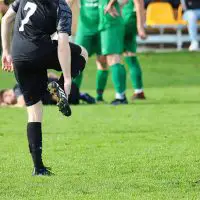Shoulder pain is a common complaint among athletes and sports enthusiasts. It can sideline even the most dedicated players, affecting their performance and overall game enjoyment.
In this blog, we’ll delve into the prevalence of shoulder pain in sports, shedding light on its causes and emphasizing the importance of understanding and addressing this issue. By being informed, you can take the necessary steps to prevent, manage, and treat shoulder pain, ensuring a healthy and active lifestyle.

Common Causes of Shoulder Pain in Sports
In sports, shoulder pain can significantly hinder an athlete’s performance and enjoyment. To help you better understand the potential reasons behind shoulder discomfort, we have compiled a list of common causes of shoulder pain related to sports activities.
Rotator Cuff Injuries
A rotator cuff is a group of four muscles and their corresponding tendons surrounding the shoulder joint, providing stability and enabling a wide range of motion. Injuries to the rotator cuff can occur from overuse, acute trauma, or degeneration.
Athletes who perform repetitive overhead movements, such as swimmers, tennis players, and baseball pitchers, are particularly susceptible to rotator cuff injuries. These injuries can manifest as strains, tears, or inflammation of the tendons (tendinitis).
Dislocations and Subluxations
A dislocation occurs when the head of the humerus (upper arm bone) is forced out of the glenoid cavity (socket) of the scapula (shoulder blade). Conversely, subluxation is a partial dislocation where the humeral head slips partially out of the socket.
Both conditions can result from direct impact or extreme force applied to the shoulder, as seen in contact sports like football, rugby, or martial arts. Dislocations and subluxations can cause severe pain, swelling, and limited range of motion.
Labrum Tears (SLAP Tears)
The labrum is a ring of cartilage that lines the shoulder socket and helps stabilize the shoulder joint. A SLAP (Superior Labrum Anterior to Posterior) tear is a labrum injury at the top of the shoulder socket where the biceps tendon attaches.
SLAP tears are often the result of repetitive overhead motions, such as those in volleyball, basketball, or weightlifting, or from a single traumatic event like a fall on an outstretched arm. Athletes with SLAP tears may experience pain, a catching sensation, and decreased shoulder strength.
Tendinitis and Bursitis
Tendinitis is the inflammation of a tendon, the fibrous tissue that connects muscle to bone. In the shoulder, tendinitis often affects the rotator cuff or biceps tendons.
Similarly, bursitis is the inflammation of the bursa, a fluid-filled sac that reduces friction between tissues in the shoulder joint.
Both tendinitis and bursitis can result from overuse or repetitive strain on the shoulder and may cause pain, swelling, and stiffness.
Sports with Higher Risk of Shoulder Pain
Baseball and Softball
Baseball and softball players often experience shoulder pain due to the repetitive and high-velocity nature of throwing and hitting. Pitchers, in particular, are susceptible to injuries such as rotator cuff tears, labral tears, and shoulder impingements.
Proper throwing mechanics, regular strength training, and adequate recovery time between games and practices can help reduce the risk of injury for these athletes.
Swimming
Swimmers are known for their strong shoulders, but the repetitive overhead motions in swimming strokes can lead to shoulder pain. Conditions like swimmer’s shoulder, impingement syndrome, and rotator cuff tendinitis are common among swimmers.
Incorporating proper swimming techniques, a balanced strength training program, and sufficient rest can help prevent shoulder injuries in the pool.
Tennis and Racquet Sports
Tennis, squash, and other racquet sports require a combination of powerful overhead swings and quick, agile movements. This puts significant stress on the shoulder joint, which can lead to injuries such as rotator cuff tears, biceps tendinitis, and shoulder instability.
Players can minimize the risk of injury by using proper swing techniques, warming up before matches, and participating in shoulder strengthening and flexibility exercises.
Weightlifting and Gymnastics
Weightlifters and gymnasts place immense stress on their shoulder joints during training and competition. Overhead lifts, handstands, and other activities can contribute to shoulder pain and injuries.
Common issues include rotator cuff strains, labral tears, and impingement syndrome. Athletes should focus on the appropriate form, gradually increasing the intensity of their workouts and including shoulder-specific strengthening and mobility exercises in their training regimens to avoid injury.
Signs and Symptoms of Shoulder Pain
Persistent Pain and Discomfort
One of the primary indicators of shoulder issues stemming from sports is persistent pain and discomfort. This discomfort can vary from a dull ache to a sharp, stabbing sensation. It may worsen during specific movements, such as lifting the arm overhead, throwing, or reaching behind the back. The pain might also intensify at night, making sleeping on the affected side difficult.
Limited Range of Motion
Another common symptom of shoulder pain related to sports is a limited range of motion. Athletes may find it challenging to perform their usual activities due to stiffness or an inability to move the shoulder through its full range of motion.
This restriction can affect an individual’s overall performance and might even hinder everyday tasks, such as putting on a shirt or reaching for objects on high shelves.
Weakness in the Affected Arm
In addition to pain and limited mobility, athletes with shoulder injuries may experience weakness in the affected arm. This loss of strength can make it difficult to perform tasks that require lifting or pushing, such as carrying groceries or opening a heavy door.
Athletes must pay attention to this weakness, as it may indicate an underlying issue that requires medical intervention.
Popping or Clicking Sounds During Movement
Finally, if you notice popping or clicking sounds when moving your shoulder, it could be a sign of a shoulder injury. These sounds, also known as crepitus, can result from tendons or ligaments rubbing against the bones in the joint or from damaged cartilage.
While some crepitus can be normal, particularly in older individuals, athletes experiencing these sounds and other symptoms should consult a healthcare professional to determine the cause and develop an appropriate treatment plan.
Prevention Tips for Shoulder Pain in Sports
As per Dallas shoulder surgeons, a successful athlete knows prevention is better than cure. Implementing the right strategies can help you avoid shoulder pain and reduce the risk of injury while participating in sports.
Proper Warm-up and Stretching Techniques
Before engaging in any sports activity, it’s essential to warm up your muscles and joints to increase blood flow and flexibility. Begin with a gentle, full-body warm-up, focusing on the shoulders with dynamic stretches such as arm circles and shoulder rolls.
Once warmed up, move on to static stretches targeting the muscles around the shoulder, holding each stretch for 15-30 seconds. This routine helps prepare your shoulders for the demands of your chosen sport and reduces the risk of injury.
Strengthening Exercises for Shoulder Stability
Incorporating strengthening exercises into your fitness regimen can improve shoulder stability and reduce the likelihood of injury. Focus on exercises that target the rotator cuff muscles and the larger muscles surrounding the shoulder, like the deltoids and trapezius.
Resistance bands, dumbbells, and bodyweight exercises like push-ups and pull-ups are excellent ways to build strength in these muscles. Be sure to include exercises that promote scapular stability, as a strong, stable shoulder blade is crucial for overall shoulder health.
Maintaining Good Posture and Form During Activities
Poor posture and incorrect form can strain your shoulder muscles, increasing the risk of injury. Always pay attention to your body alignment when engaging in sports activities. Keep your shoulders back and down, and avoid hunching or rounding them forward.
Proper form while performing exercises and sports-specific movements can also help prevent shoulder pain. If you need help with your technique, consult a coach or sports professional to ensure you perform activities correctly and safely.
Gradual Increase of Intensity and Duration in Sports
Avoid jumping into high-intensity sports activities without proper preparation. Gradually increasing the intensity and duration of your workouts allows your body, including your shoulder muscles and joints, to adapt to the increased stress.
This measured approach helps prevent overuse injuries, common causes of shoulder pain in athletes. Be sure to listen to your body, rest when needed, and avoid pushing through pain, as this can exacerbate or create new issues.
Treatment Options for Shoulder Pain
If you’re an athlete or fitness enthusiast, experiencing shoulder pain can be frustrating and may impact your performance. Fortunately, several effective treatment options can help you get back in the game.
Rest, Ice, Compression, and Elevation (RICE)
The initial treatment for many sports-related shoulder injuries involves the RICE method. Giving the affected shoulder adequate rest and modifying your activities can help prevent further damage.
Applying ice to the injured area can reduce swelling and inflammation, while gentle compression with a bandage or wrap can support and minimize swelling. Elevating the wounded shoulder above heart level can also help reduce swelling and promote healing.
Physical Therapy and Rehabilitation
Engaging in a physical therapy program designed to address your specific shoulder injury is crucial for restoring strength, flexibility, and range of motion.
A skilled physical therapist can guide you through targeted exercises and stretches to address muscle imbalances, improve joint stability, and facilitate a safe return to your sport or activity.
Medication for Pain and Inflammation
To manage pain and inflammation associated with shoulder injuries, your healthcare provider may recommend over-the-counter or prescription medications. Nonsteroidal anti-inflammatory drugs (NSAIDs), such as ibuprofen and naproxen, can be beneficial in reducing pain and swelling. Following your healthcare provider’s recommendations for medication usage and dosage is essential.
Surgical Interventions, if Necessary
In some cases, conservative treatment options may not provide adequate relief, and surgical intervention may be necessary. Depending on the severity and nature of your shoulder injury, your healthcare provider may recommend minimally invasive arthroscopic or open surgery. Surgical options aim to repair damaged structures, remove bone spurs or scar tissue, and restore shoulder function.
Conclusion
In conclusion, shoulder pain from sports is a common yet controllable problem affecting many sportsmen. Understanding the architecture of the shoulder, the numerous causes of discomfort, and the signs and symptoms to look for can help you take an active part in your health and well-being.
Prioritizing preventative techniques and obtaining professional assistance are critical for a pain-free and joyful athletic experience. By remembering these tips, you can continue participating in your favorite sports while lowering your chance of injury. Keep educated, stay fit, and have fun!


